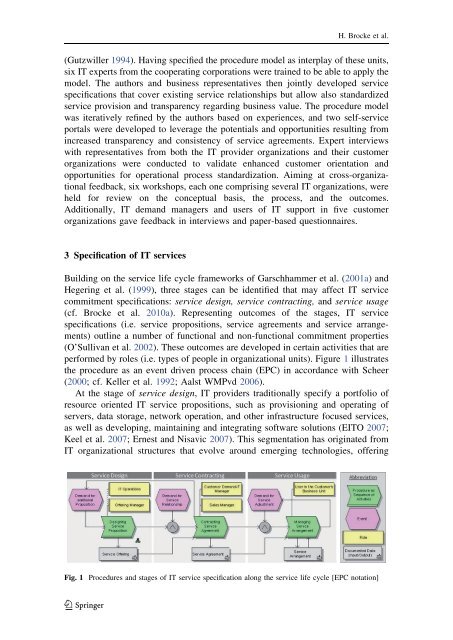Kundenorientierte Gestaltung und Vereinbarung standardisierter IT ...
Kundenorientierte Gestaltung und Vereinbarung standardisierter IT ...
Kundenorientierte Gestaltung und Vereinbarung standardisierter IT ...
Erfolgreiche ePaper selbst erstellen
Machen Sie aus Ihren PDF Publikationen ein blätterbares Flipbook mit unserer einzigartigen Google optimierten e-Paper Software.
(Gutzwiller 1994). Having specified the procedure model as interplay of these units,<br />
six <strong>IT</strong> experts from the cooperating corporations were trained to be able to apply the<br />
model. The authors and business representatives then jointly developed service<br />
specifications that cover existing service relationships but allow also standardized<br />
service provision and transparency regarding business value. The procedure model<br />
was iteratively refined by the authors based on experiences, and two self-service<br />
portals were developed to leverage the potentials and opportunities resulting from<br />
increased transparency and consistency of service agreements. Expert interviews<br />
with representatives from both the <strong>IT</strong> provider organizations and their customer<br />
organizations were conducted to validate enhanced customer orientation and<br />
opportunities for operational process standardization. Aiming at cross-organizational<br />
feedback, six workshops, each one comprising several <strong>IT</strong> organizations, were<br />
held for review on the conceptual basis, the process, and the outcomes.<br />
Additionally, <strong>IT</strong> demand managers and users of <strong>IT</strong> support in five customer<br />
organizations gave feedback in interviews and paper-based questionnaires.<br />
3 Specification of <strong>IT</strong> services<br />
H. Brocke et al.<br />
Building on the service life cycle frameworks of Garschhammer et al. (2001a) and<br />
Hegering et al. (1999), three stages can be identified that may affect <strong>IT</strong> service<br />
commitment specifications: service design, service contracting, and service usage<br />
(cf. Brocke et al. 2010a). Representing outcomes of the stages, <strong>IT</strong> service<br />
specifications (i.e. service propositions, service agreements and service arrangements)<br />
outline a number of functional and non-functional commitment properties<br />
(O’Sullivan et al. 2002). These outcomes are developed in certain activities that are<br />
performed by roles (i.e. types of people in organizational units). Figure 1 illustrates<br />
the procedure as an event driven process chain (EPC) in accordance with Scheer<br />
(2000; cf. Keller et al. 1992; Aalst WMPvd 2006).<br />
At the stage of service design, <strong>IT</strong> providers traditionally specify a portfolio of<br />
resource oriented <strong>IT</strong> service propositions, such as provisioning and operating of<br />
servers, data storage, network operation, and other infrastructure focused services,<br />
as well as developing, maintaining and integrating software solutions (E<strong>IT</strong>O 2007;<br />
Keel et al. 2007; Ernest and Nisavic 2007). This segmentation has originated from<br />
<strong>IT</strong> organizational structures that evolve aro<strong>und</strong> emerging technologies, offering<br />
Fig. 1 Procedures and stages of <strong>IT</strong> service specification along the service life cycle [EPC notation]<br />
123

















